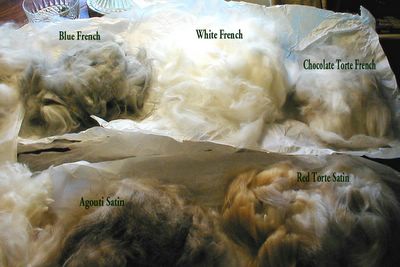Here are a few photos of the fiber. I wanted to photograph the whole clip as one photo, but it just would not fit and give the detail. As it is, the photos still do not show well the sheen of the satin fiber. I love both the French and Satin fiber, but for two different reasons. The French fiber is just plain luxury to spin and easiest of all the angora to spin. The satin is hard to spin, but if it is spun as a 100% skein the resulting yarn just shines plus has a halo. It is a very unique and lovely yarn.

Spring clip1
The himi satin looks white, but in truth has a brown tipping to many of the fibers. The rabbits (I have two) are unique in that they have blue/grey eyes instead of the red eyes associated with white rabbits. Also the brown coloring changes with the weather so in colder weather they will be browner and lose it in the summer. I don't see a very drastic change on my rabbits, they tend to be in a moderate temperature year round, by living in the barn. And the rabbits always 'look' white, the coloration is just in the tipping. It has to be taken into account though when spinning the fiber, it will not look white when spun.
In the middle of this photo, the red fiber, is from the only mix breed rabbit I have left from a breeding project I had started. The goal was to get the longer french fiber into the satin, and to get the intense red of the satin into the french. One very large litter was born from that mix breeding and most found homes with other breeders because they had more intense red coloration. Since I then decided I had to cut back on the rabbit business, I did not carry the genetic line any further. The plan had been to take that first generation and breed back to type, satin to satin and french to french. It would have taken five generations to be considered pure back to type, so it was a long term project. I would have enjoyed it too, however my life demands more travel time, and I just had to put rabbit breeding aside for that reason.
The black satin fiber is as awesome as it sounds. I dearly love that black rabbit, a very shy male that I have had for three years now. The clip was the longest coat I have seen him have, and it was easy to trim. Often satin can be very short, but the winter weather must have encouraged more growth, because most of my satins had longer than normal for them coats.

Spring clip2
The top three are my major french rabbits. The blue is the pet called Reboot because my daughter found the baby out of the nest, warmed her up and she lived. She is a monster rabbit now, well over 10 pounds, probably not real healthy for her, but I get a major amount of fiber from her on a regular basis. I have used the blue angora as trim for items knit from grey wool fiber (CVM mostly) and the two colors look wonderful together.
The chocolate torte is another wonderful color to spin. The yarn is very tweedy in appearance, browns, reds and greys. That's because the coloring on the fiber shaft goes from an almost white base to a deep red/brown tip. I must confess I have dyed angora, but usually feel there is no need, the natural colors are my favorites.

Spring clip3
There is one coloration problem on this photo, I seem to be unable to get a photo that didn't put a red tint to the lilac satin at the bottom of this photo. If you saw the fiber in person, it is a true white base and silver tipped fiber. The two satin fibers above it in the photo are so red, I suppose the color is reflecting on the lilac.
I realized as I looked at the rabbits in my barn now, that I have equal numbers of french and satin. And also that this number of rabbits is perfect to keep me a supply of angora to spin. I think I have finally reached a nice balance between necessary work and fun for this rabbit hobby.
CW
2 comments:
Lovely fibers! You mention that you do not like clipped angora for spinning, but prefer plucked. Will you blend the angora that you clipped with wool? The colors you have are just stunning!
I raise German's which need to be clipped as they do not release their coats, like the other angoras. I usually blend my angora with merino and have not had too many problems with the clipped ends.
Oh I do use clipped fiber for my own personal spinning, and often will blend it on my drum carder with merino. I will even spin it as a 100% angora yarn. The difference is that I know I may get more shedding with that skein. The shorter clipped fibers tend to work their way out of the twist easier than the longer plucked fiber.
My difference between plucked and clipped is usually just the length. If I am clipping everyone down because of the heat, I will get shorter fibers than I'd like to sell. With your German angoras, you can allow the coat to reach a good length and then clip. Also your German's grow their coats faster than my Satins. Sometimes with the satins I only harvest fiber twice a year. I know the German's are breed to produce much more fiber than that. I raise the satin's though because as you point out, the colors are amazing.
CW
Post a Comment